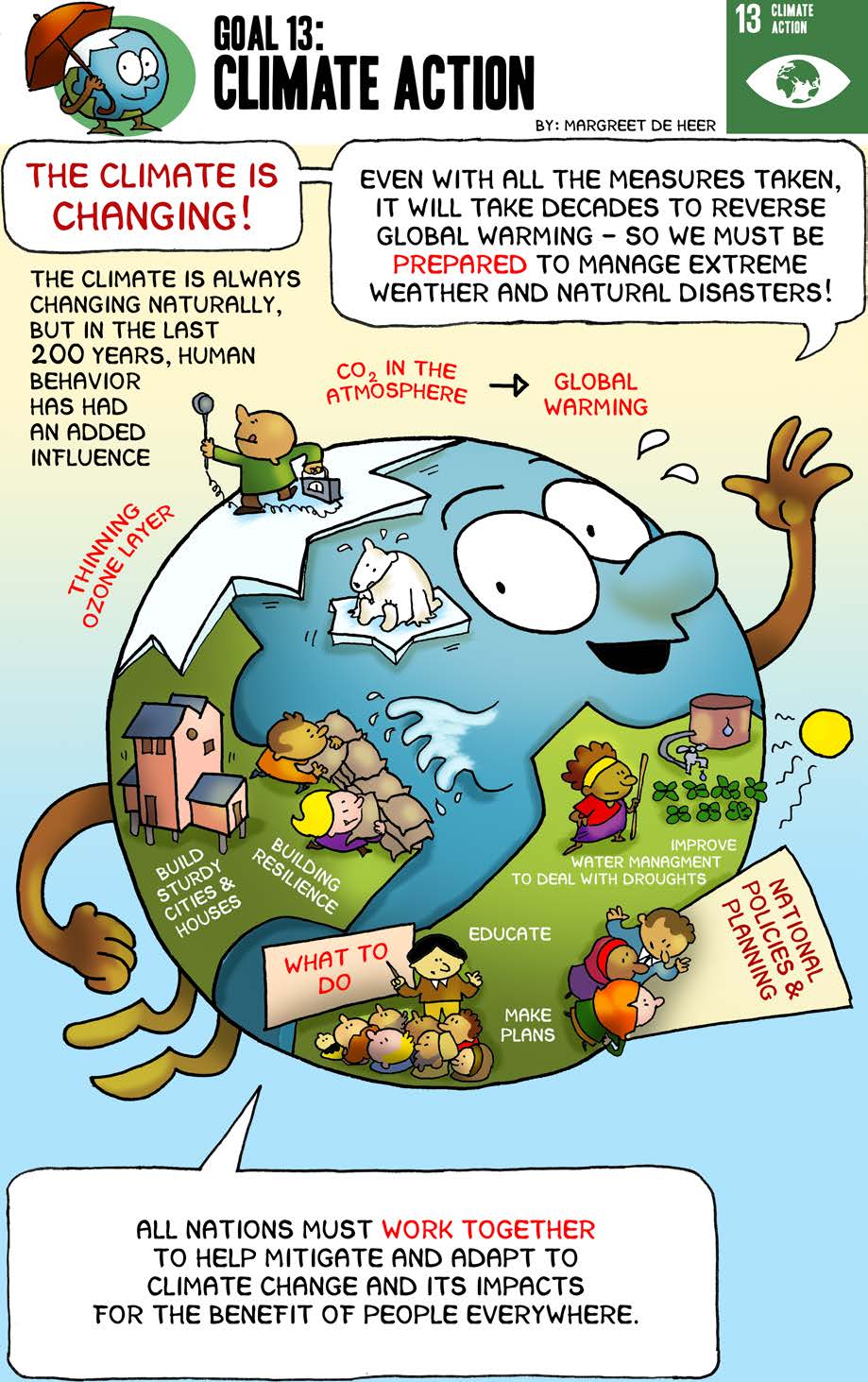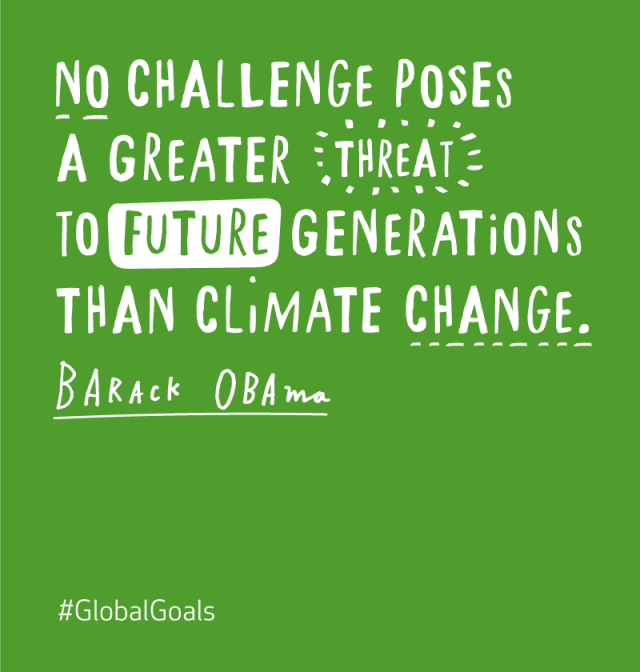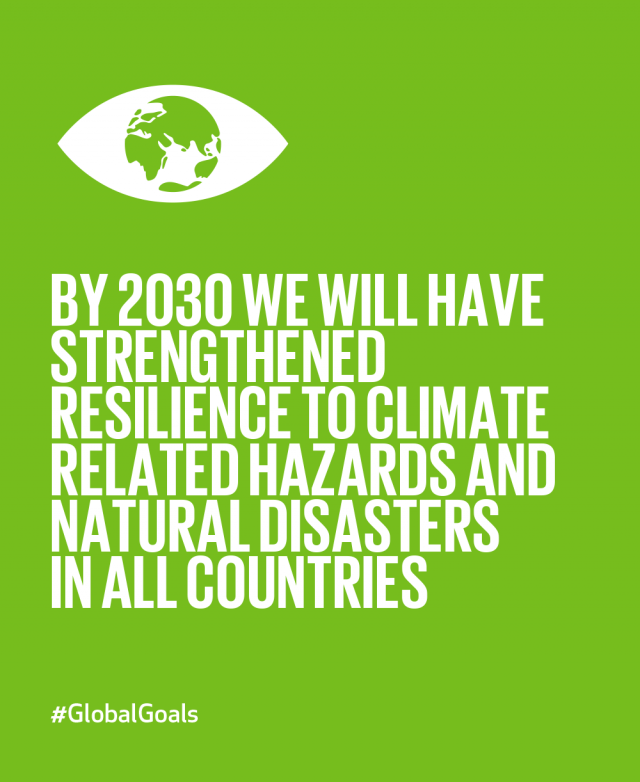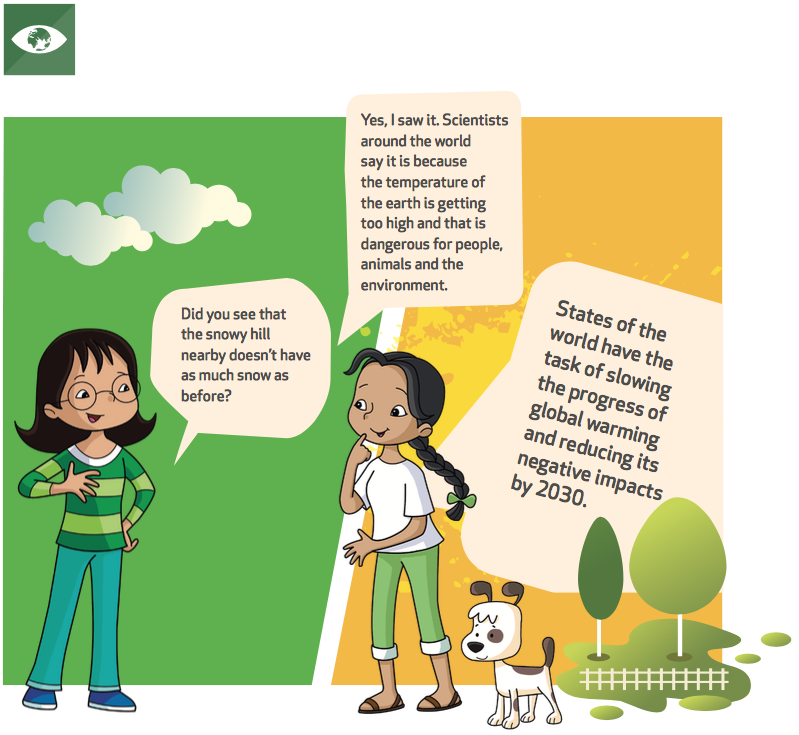13. Climate Action

Take urgent action to combat climate change and its impacts
Why It Matters

Climate change is now affecting every country on every continent. It is disrupting national economies and affecting lives, costing people, communities and countries dearly today and even more tomorrow.
People are experiencing the significant impacts of climate change, which include changing weather patterns, rising sea level, and more extreme weather events. The greenhouse gas emissions from human activities are driving climate change and continue to rise. They are now at their highest levels in history. Without action, the world’s average surface temperature is projected to rise over the 21st century and is likely to surpass 3 degrees Celsius this century—with some areas of the world expected to warm even more. The poorest and most vulnerable people are being affected the most.
Affordable, scalable solutions are now available to enable countries to leapfrog to cleaner, more resilient economies. The pace of change is quickening as more people are turning to renewable energy and a range of other measures that will reduce emissions and increase adaptation efforts.
But climate change is a global challenge that does not respect national borders. Emissions anywhere affect people everywhere. It is an issue that requires solutions that need to be coordinated at the international level and it requires international cooperation to help developing countries move toward a low-carbon economy.
To address climate change, countries adopted the Paris Agreement at the COP21 in Paris on 12 December 2015. The Agreement entered into force shortly thereafter, on 4 November 2016. In the agreement, all countries agreed to work to limit global temperature rise to well below 2 degrees Celsius, and given the grave risks, to strive for 1.5 degrees Celsius. You can learn more about the agreement here.
Implementation of the Paris Agreement is essential for the achievement of the Sustainable Development Goals, and provides a roadmap for climate actions that will reduce emissions and build climate resilience.
Facts & Figures

- From 1880 to 2012, average global temperature increased by 0.85°C. To put this into perspective, for each 1 degree of temperature increase, grain yields decline by about 5 per cent. Maize, wheat and other major crops have experienced significant yield reductions at the global level of 40 megatonnes per year between 1981 and 2002 due to a warmer climate.
- Oceans have warmed, the amounts of snow and ice have diminished and sea level has risen. From 1901 to 2010, the global average sea level rose by 19 cm as oceans expanded due to warming and ice melted. The Arctic’s sea ice extent has shrunk in every successive decade since 1979, with 1.07 million km² of ice loss every decade
- Given current concentrations and on-going emissions of greenhouse gases, it is likely that by the end of this century, the increase in global temperature will exceed 1.5°C compared to 1850 to 1900 for all but one scenario. The world’s oceans will warm and ice melt will continue. Average sea level rise is predicted as 24 – 30cm by 2065 and 40-63cm by 2100. Most aspects of climate change will persist for many centuries even if emissions are stopped
- Global emissions of carbon dioxide (CO2) have increased by almost 50 per cent since 1990
- Emissions grew more quickly between 2000 and 2010 than in each of the three previous decades
- It is still possible, using a wide array of technological measures and changes in behaviour, to limit the increase in global mean temperature to two degrees Celsius above pre-industrial levels
- Major institutional and technological change will give a better than even chance that global warming will not exceed this threshold
Targets

• Ensure people are well prepared for hazards related to climate and natural disasters.
• Address climate change issues in their governments’ agendas and allocate resources to combat climate change.
Take Action

- Offset your carbon emissions! You can calculate your carbon footprint and purchase climate credit.
- Eatting less red meat and better farming practices could cut greenhouse gases by a third. Harmful emissions from livestock account for 14.5% of all human-caused greenhouse gases.
- Bike, walk or take public transport. Save the car trips for when you've got a big group.
- Raise awareness about climate change among children and young people so they know how to address it. This is crucial so we can all live a sustainable future.
Companies can be part of the solution by committing to decarbonize their oper- ations and supply chains.
They can do this by:
• Improving their energy efficiency
• Reducing the carbon footprint of their products, services and processes
• Setting emissions reductions targets in line with climate science
• Scaling up investment in the development of innovative and inclusive low- carbon, climate-smart products and services
• Prepare to adapt to climate change and build resilience in their operations, supply chains and the communities in which they operate